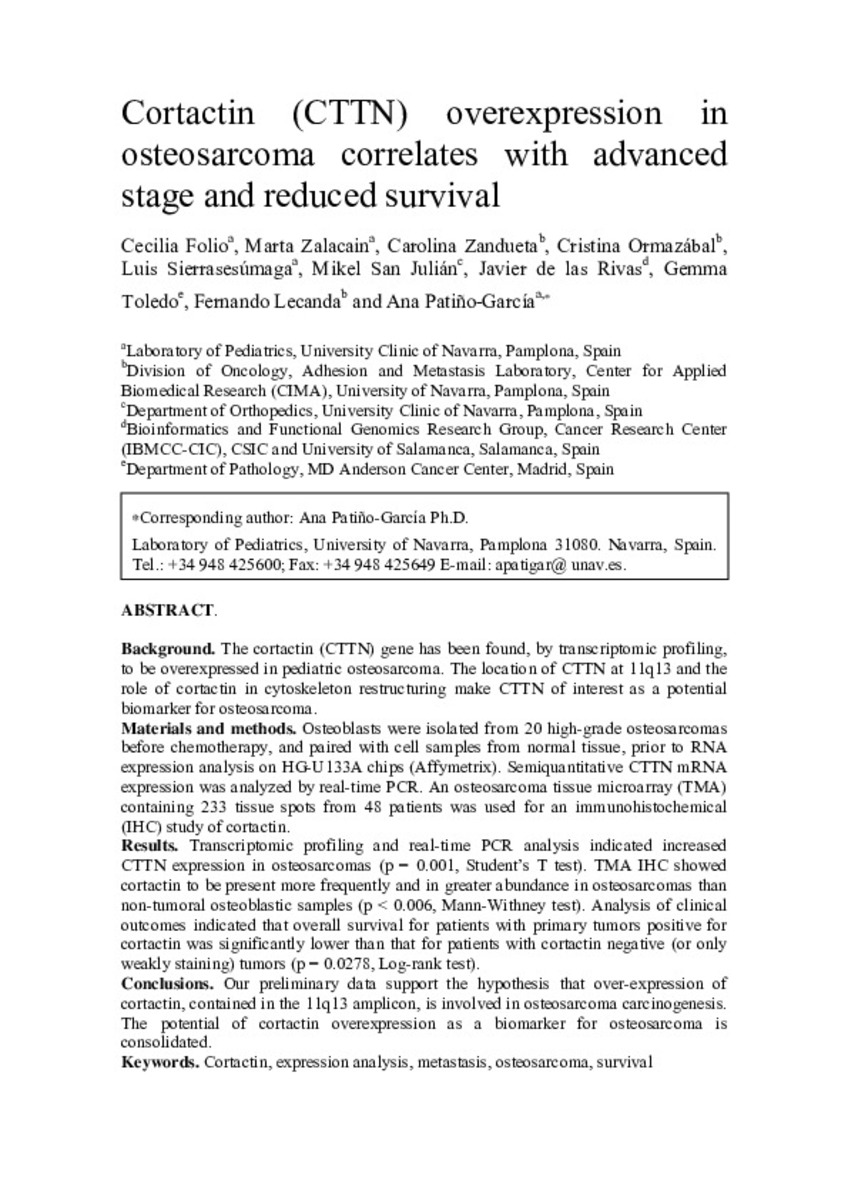Full metadata record
| DC Field | Value | Language |
|---|---|---|
| dc.creator | Folio, C. (Cecilia) | - |
| dc.creator | Zalacain, M. (Marta) | - |
| dc.creator | Zandueta, C. (Carolina) | - |
| dc.creator | Ormazábal, C. (Cristina) | - |
| dc.creator | Sierrasesumaga, L. (Luis) | - |
| dc.creator | San-Julian, M. (Mikel) | - |
| dc.creator | Rivas, J. (Javier) de las | - |
| dc.creator | Toledo, G. (Gemma) | - |
| dc.creator | Lecanda, F. (Fernando) | - |
| dc.creator | Patiño-García, A. (Ana) | - |
| dc.date.accessioned | 2012-11-22T09:36:48Z | - |
| dc.date.available | 2012-11-22T09:36:48Z | - |
| dc.date.issued | 2011 | - |
| dc.identifier.citation | Folio C, Zalacain M, Zandueta C, Ormazabal C, Sierrasesumaga L, San Julian M, et al. Cortactin (CTTN) overexpression in osteosarcoma correlates with advanced stage and reduced survival. Cancer Biomark 2011 -2012;10(1):35-41. | es_ES |
| dc.identifier.issn | 1574-0153 | - |
| dc.identifier.uri | https://hdl.handle.net/10171/23762 | - |
| dc.description.abstract | The cortactin (CTTN) gene has been found, by transcriptomic profiling, to be overexpressed in pediatric osteosarcoma. The location of CTTN at 11q13 and the role of cortactin in cytoskeleton restructuring make CTTN of interest as a potential biomarker for osteosarcoma. MATERIALS AND METHODS: Osteoblasts were isolated from 20 high-grade osteosarcomas before chemotherapy, and paired with cell samples from normal tissue, prior to RNA expression analysis on HG-U133A chips (Affymetrix). Semiquantitative CTTN mRNA expression was analyzed by real-time PCR. An osteosarcoma tissue microarray (TMA) containing 233 tissue spots from 48 patients was used for an immunohistochemical (IHC) study of cortactin. RESULTS: Transcriptomic profiling and real-time PCR analysis indicated increased CTTN expression in osteosarcomas (p = 0.001, Student's T test). TMA IHC showed cortactin to be present more frequently and in greater abundance in osteosarcomas than non-tumoral osteoblastic samples (p< 0.006, Mann-Withney test). Analysis of clinical outcomes indicated that overall survival for patients with primary tumors positive for cortactin was significantly lower than that for patients with cortactin negative (or only weakly staining) tumors (p = 0.0278, Log-rank test). CONCLUSIONS: Our preliminary data support the hypothesis that over-expression of cortactin, contained in the 11q13 amplicon, is involved in osteosarcoma carcinogenesis. The potential of cortactin overexpression as a biomarker for osteosarcoma is consolidated. | es_ES |
| dc.language.iso | eng | es_ES |
| dc.publisher | IOS Press | es_ES |
| dc.rights | info:eu-repo/semantics/openAccess | es_ES |
| dc.subject | Bone Neoplasms/genetics/mortality/pathology | es_ES |
| dc.subject | Cortactin/genetics/metabolism | es_ES |
| dc.subject | Osteosarcoma/genetics/mortality/pathology | es_ES |
| dc.title | Cortactin (CTTN) overexpression in osteosarcoma correlates with advanced stage and reduced survival | es_ES |
| dc.type | info:eu-repo/semantics/article | es_ES |
| dc.relation.publisherversion | http://iospress.metapress.com/content/j410gh0xx6l62330/fulltext.pdf | es_ES |
| dc.type.driver | info:eu-repo/semantics/article | es_ES |
Files in This Item:
Statistics and impact
Items in Dadun are protected by copyright, with all rights reserved, unless otherwise indicated.






